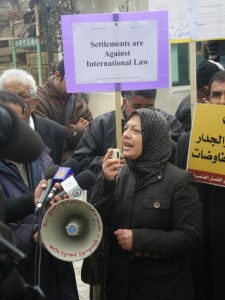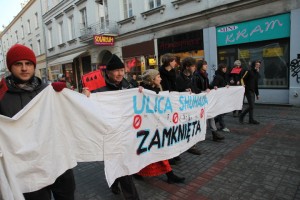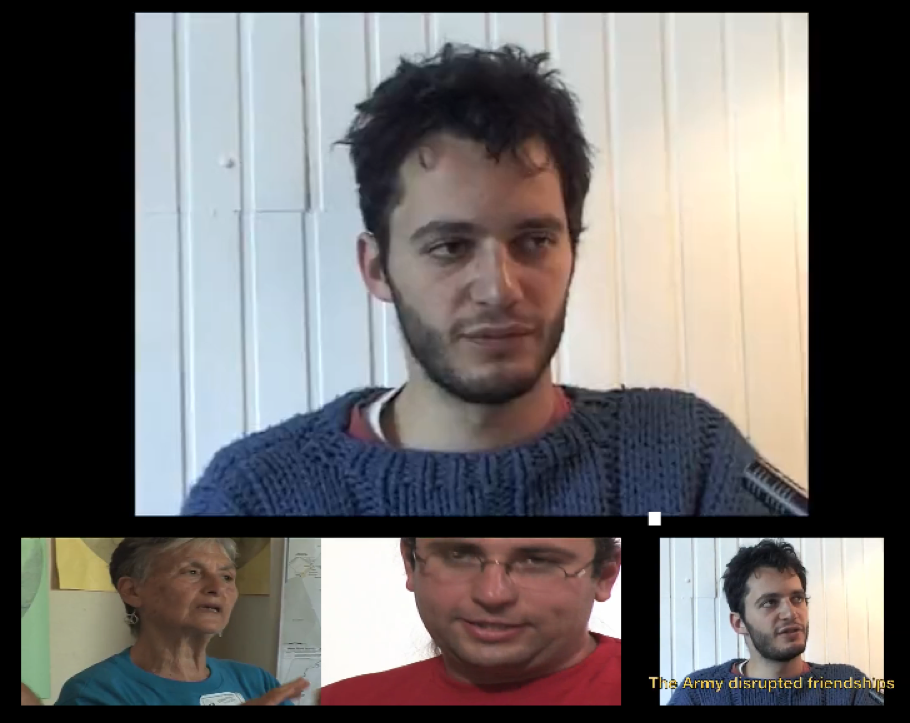The Only Democracy? » On The Ground Reports » A Closed Street Opens a Door to a Global Movement
A Closed Street Opens a Door to a Global Movement
-By Avital Aboody
On the afternoon of February 25, 2010, diverse groups of activists around the world took to the streets to protest the official policy of separation in Hebron that has severely restricted Palestinian freedom of movement in the area around the Jewish settlement, and effectively turned a once vibrant city center into a virtual ghost town. Armed only with the support and encouragement of these fellow activists, a group of approximately 300 Palestinians, Israelis, and Internationals joined hands and marched toward Shuhada Street in Hebron. Shuhada Street was once the sight of the principal marketplace in the city yet has been closed to Palestinians for the past 16 years, justified by the military as a necessary security measure to reduce friction between the settlers and Palestinians in the aftermath of the murder of 29 Palestinians in prayer by a settler named Baruch Goldstein.
In preparation for the protest, members of the democracy activist community in Israel discussed how to successfully bring groups of Israelis to Hebron to support the Palestinian residents of Hebron in this action. The organizing was characterized by the standard anxiety about the possibility of tapped phones and email accounts, the chance of being stopped and detained before reaching the protest sight, and the likelihood of facing arrest and/or a violent repression from the army, police, or, even more threatening, the settlers. The use of such tactics, intended to silence voices of dissent and prevent activists from exposing the truly undemocratic features of our beloved “Jewish democracy”, are not uncommon practices in the constant struggle for legitimacy within the Israeli public discourse. There is an element of irony in the fact that a country promoting itself as the beacon of freedom of expression in the Middle East is so entrenched in monitoring the activities of human rights activists, that they find their speech limited to such an extent that they are forced to communicate in codes or not speak at all in order not to sabotage their efforts to participate in the creation of a true democracy that ensures the civil rights of all peoples in Israel-Palestine.

Somehow, despite reports that the army was patrolling the main road between Jerusalem and Hebron (Route 60) with the aim to prevent Israelis from reaching the protest, several groups of dedicated activists were able to successfully enter the city, assist in making posters that espoused messages of justice, shared humanity, and equality, and then proceed to march in the rain waving flags, linking arms, and chanting slogans in Arabic, Hebrew, and English. The protesters remained true to their commitment to nonviolence, yet they were met by a very heavy army presence which was quick to deploy harsh crowd dispersal techniques that included a heavy amount of tear gas and stun grenades. Tear gas canisters were fired into the crowd from all directions, often coming very close to hitting people. A few elderly protesters fainted and were evacuated by ambulance. Some protestors sustained some minor injuries, including temporary loss of hearing due to proximity of the stun grenades which produce a very loud and frightening blast. Protestors scattered and ran to avoid the clouds of tear gas that caused a burning and choking sensation, but the soldiers were surrounding the protest and shooting from all angles. The soldiers continually tried to hold the protesters further back by creating a human wall and physically pushing the protesters who, in response, formed their own wall to withstand the pressure. This pushing back and forth, which continued for nearly an hour, looked like a childish fight between rival groups on the playground, except in this scene one group carried guns and had a mandate from the government, while the other group came without weapons and was denied their rightful protection by that same government. Three Israelis were picked out the crowd at random with no stated or apparent cause and taken away by the police and detained temporarily. One international activist was arrested, also without just cause, and then released several hours later. The clashes between the military, police, protesters, and a few notorious settlers continued for about an hour and 45 minutes until a final barrage of tear gas caused everyone to retreat and run up the hill or into the nearby cemetery where, in Hebron, it seems that people go not only to bury their dead but also their dignity, which perishes at the hands of the occupation.
As the sun set on February 25, 2010, Palestinian and Israeli organizers of the day exchanged affectionate glances and handshakes and returned to their separate lives in Hebron and Jerusalem, respectively. The two cities are a mere 45 minutes apart yet the reality of life for these allies is unequivocally different. Despite all the struggles that Israeli activists face as a minority voice in Israel, they still go back to homes that are not defaced with hateful graffiti, are not blocked by a series of checkpoints, are not raided by the army at any given moment, and are not caged up to shield against the onslaught of rock throwing from hostile neighbors. This is the reality of life for residents of Hebron who have the great misfortune of living in an occupied city. This is the reality that the Israeli government supports through subsidies for settlements, heritage preservation funds for holy sites beyond the green line, and a general unwillingness to acknowledge the suffering it inflicts on the Palestinian population by controlling every aspect of their lives.
This global day of solidarity and action demanded that the stories of the Palestinian residents of Hebron to be heard and considered, and we hope that this widespread coordinated effort can be a catalyst to the creation of more alliances which together will challenge the status quo and bring about necessary changes in Israel-Palestine.
Here again is a short video clip of the event.
Filed under: On The Ground Reports · Tags: Hebron, Open Shuhada Street










 “You have a choice! Israeli Anti-Militarists Speak”
“You have a choice! Israeli Anti-Militarists Speak”